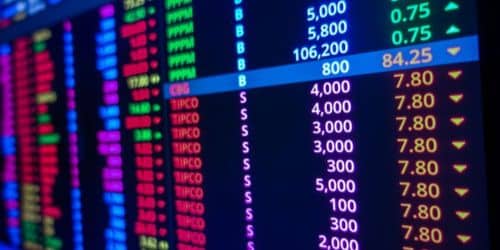The dividend stock yield displays the total amount of dividend payments made by a company in a given year. The yield is shown as a percentage rather than as a precise dollar amount. This makes it simpler to understand how much profit the shareholder can anticipate receiving for every dollar invested. Understanding dividend yield and how it works will help you optimize your dividend strategy and compare investment options accurately.
Stock Yield
A stock’s dividend yield reveals how much recurring income shareholders received over the previous year as a proportion of the market value of their shares. The dividend yield is frequently used by investors to determine whether it would be profitable to purchase and hold a stock. Businesses keep a certain amount of their profits to reinvest in the company while distributing a portion of those profits as dividends.
A company’s shareholders receive dividend payments. The amount of earnings based on all dividend payments that investors receive from holding that company’s stock is measured by dividend yield. Stocks with dividend yields could be a great choice for investors seeking passive income. Shares of a company that regularly give investors a portion of its earnings are known as dividend stocks. Dividend stocks may also help stabilize your portfolio because dividend-paying companies are frequently well-established.
How to Invest in Dividend Stocks
Building a portfolio of individual dividend stocks is something that many investors find to be worthwhile, despite the time and effort required. How to purchase a dividend stock is as follows:
#1. Look for a Stock That Pays Dividends
Many financial websites, including the website of your online broker, allow you to search for stocks that pay dividends. Therefore, thoroughly search for stocks that pay out dividends.
#2. Assess the Stock
Start by evaluating the dividend yields of a high-dividend stock’s competitors before digging deeper. A warning sign might be a company’s dividend yield if it is significantly higher than the yields of its peer group. At the very least, further investigation into the business and the dividend’s security is worthwhile.
#3. Check the Stock’s Payout Ratio
The stock payout ratio reveals the percentage of the company’s revenue that is allocated to dividends. An excessive payout ratio, which is generally above 80% but can vary by industry, indicates that a significant portion of the company’s earnings are going toward dividend payments.
#4. Choose the Quantity of Stock You Wish to Purchase
Determining what proportion of your portfolio is invested in each stock is necessary if you plan to buy individual stocks because you need diversification. For example, if you’re buying 20 stocks, you could put 5% of your portfolio in each. However, if the stock carries a higher level of risk, you might want to purchase less of it and allocate more funds to safer investments. Recalculating your cost basis, or the price you originally paid for the stock, is necessary if you plan to reinvest your dividends.
Dividend yields greater than 4% should be closely examined, and those greater than 10% should be taken very seriously because they are risky. A high dividend yield, among other things, may be a sign that the payout is unsustainable or that stockholders are unloading their holdings, which would lower the stock price and raise the dividend yield.
Dividend Stock Yield
A measure of dividend payouts per dollar invested in a stock, mutual fund, or exchange-traded fund (ETF), the dividend yield is a ratio that you can use to determine your annual dividend income. Dividend yield measures how much of a security’s current price goes toward its annual dividend payment. This percentage yield reveals your annual return on investment based on the cost of the security you purchased.
Because you are earning more money for every dollar invested, a high dividend yield can be alluring, but it is not always a good thing. If dividend payments have been rising faster than the company’s earnings, it could indicate that the stock price of the company has been declining.
What Affects Dividend Yield?
#1. Stock Prices
A company’s stock price has a significant impact on dividend yield. Dividend yields decrease as share prices increase unless businesses decide to increase dividend payments. It is not always a bad thing when the dividend yield declines as a result of rising stock prices. It might imply that investors have increased faith in the business and think it is a better investment. Additionally, a declining dividend yield can be offset by the appreciation you receive from rising stock prices.
#2. Market Trends
Since dividend yields can differ significantly across sectors, industries, and fund categories, it is crucial to compare yields offered by businesses in the same industry—or funds in the same category—when evaluating dividend yields.
#3. Company Growth
In general, larger, older businesses with a track record of reliability and consistent performance are more likely to pay dividends and offer higher yields than younger, smaller businesses. Growth stocks, which are rapidly and exponentially increasing their earnings and revenues, prefer to reinvest profits over paying dividends. Due to this, dividend investors are significantly less likely to concentrate their portfolios on growth stocks.
#4. Basics of the Business
Although they can be alluring, high dividend yields occasionally indicate that a company is having issues. When the stock price drops as a result of a decline in business earnings or a drop in investor confidence, the yield may increase.
Sometimes, failing businesses will raise dividends to boost returns and draw in new investors. The company’s dividends might not be tenable, though, unless it can turn things around and keep supporting high payouts.
The Benefits of Dividend Yields
When used properly and after careful consideration of the company behind the payout’s financial viability, dividend yield can be a useful metric. Dividend yield increases over time. Evidence from the past suggests that concentrating on dividends might increase returns rather than decrease them. Following the company’s declaration of a dividend, the investor may reinvest additional shares. This is a form of compounding profits in a manner akin to that of a savings account.
Additionally, dividend yield can be a helpful tool for valuation. A stock may be trading for a better — or worse — valuation if the yield differs significantly from its historical level or from that of comparable companies. In addition, if the yield is significantly higher than that of comparable businesses, that could be a red flag.
Disadvantages of Dividend Yields
Even though high dividend yields are appealing, they may compromise the company’s potential for growth. Each dollar a business pays out in dividends to its shareholders is probably a dollar the business is not reinvesting to grow and generate more capital gains. If shareholders’ stock value increases while they hold it as a result of business growth, they may still receive higher returns even in the absence of dividend payments.
Investors are advised against analyzing a stock solely based on its dividend. When a company’s stock is falling, it often has a very high yield. The dividend amount or its elimination may be considered if a company’s stock declines sufficiently.
How to Calculate Stock Yield
The dividend yield is calculated by multiplying the dollar total of a stock or fund’s annual dividends by the share price.
Dividend Yield = Dividends Per Share / Price Per Share
Consider a company that trades shares for $50 and distributes $1.50 in annual dividends per share. The dividend yield is calculated by dividing the dividend per share by the share price: $1.50 / $50 = 0.03.
You obtain a 3% dividend yield by converting the decimal to a percentage. If you invested at this price in the company’s stock with the dividend payout remaining the same, you would receive 3% in dividends annually.
Visit the company’s investor relations website and look over its financial statements to learn how much the company paid in dividends per share. The Nasdaq dividend history tool also allows you to view the dividend track record of significant corporations.
But you have to choose which time frame to consider when figuring out an annual dividend yield. Here are a few typical techniques.
- Prior year: You will find the sum of dividend payments to shareholders in the annual financial reports of companies. This is accessible on their websites or through the U.S. Securities and Exchange Commission. You might need more recent data if it has been some time since the year’s end, though.
- Trailing 12 months (TTM): Public companies also publish quarterly reports that include dividend totals; by reviewing a number of these, you can determine a more recent total for the previous year.
- Dividends paid quarterly: To calculate the annual total, multiply the most recent quarterly dividend total by four.
What Is a Good Yield for a Stock?
Investors define a good dividend yield as falling between 2% and 6%, but there are many other factors to take into account before deciding whether a stock is a good investment based solely on its dividend yield. In large part, your investment objectives determine what constitutes a good one for you.
If the yield is greater than 4%, it might be a great investment, but it might also be quite risky. There is a reason why high-yield stocks have such a high yield, so be sure to do your research before investing in them. Because businesses calculate dividends as a percentage of stock price, they would achieve a higher yield by lowering the stock price.
Also keep in mind that if there is no dividend or one that is lower than usual, the company is probably reinvesting its profits. In the end, this might result in a much higher stock price instead of a yield.
What Is a Stock Yield vs Dividend?
The term “dividend yield” describes the portion of a company’s stock price that they currently pay out over a year. A financial ratio called the dividend yield illustrates the number of annual dividend payments a company makes in comparison to the price of its stock.
What Is the Stock Yield Formula?
Dividends are the individual source of income for stockholders in the stock market. You calculate the yield on stocks by dividing the annual dividends per share by the share price of the stock.
Stock yield = (dividends per share/stock price) x 100
Is 20% Yield Bad?
In many cases, a high dividend yield indicates risk and poor performance rather than an opportunity. Here are some reasons why individual investors should reconsider using exorbitant dividend yields as their key indicator when assessing a potential investment. This is the significance of putting the total return ahead of the dividend yield. You should include a stock’s or unit’s performance, including dividends, in the investment’s total return. An excessively high dividend yield typically denotes risk and then poor total returns over extended periods follow it.
Is a 5% Yield Good?
Divide the total annual dividend payments per share by the stock’s current price to produce the dividend yield, and express it as a percentage. A good yield is between 2% and 6%, but several variables can affect whether a payout of more or less than that indicates a stock is a wise investment.
Is a 10% Yield Good?
When markets are choppy, investing in high dividend yield stocks makes sense because these businesses provide solid payoff options. An investor should examine yields greater than 4% should closely, and take those greater than 10% very seriously because they are risky. A too-high dividend yield may, among other things, be a sign that the payout is unsustainable or that investors are offloading the stock, which lowers the share price and raises the dividend.
Conclusion
Although the dividend yield can be a significant factor in determining a stock’s return on investment, you should not base your investment decisions solely on it. Consider dividend yield as part of the overall picture, along with other metrics like performance relative to important benchmark indices and corporate fundamentals, to ensure that your investments are sound over the long term.
Investors should exercise caution when evaluating a company that has a higher dividend yield than the industry average and seems to be having financial difficulties. A sharp decline in the stock price, which serves as the denominator in the yield equation, has the potential to significantly increase the calculation’s quotient.
Related Articles
- WHAT IS A DIVIDEND: Example, Stocks, Payment on Shares, & Income
- DIVIDEND INDEX FUNDS: Best High Index Funds Fidelity & Vanguard
- DIVIDEND INVESTING: Meaning, How It Works and Cons






